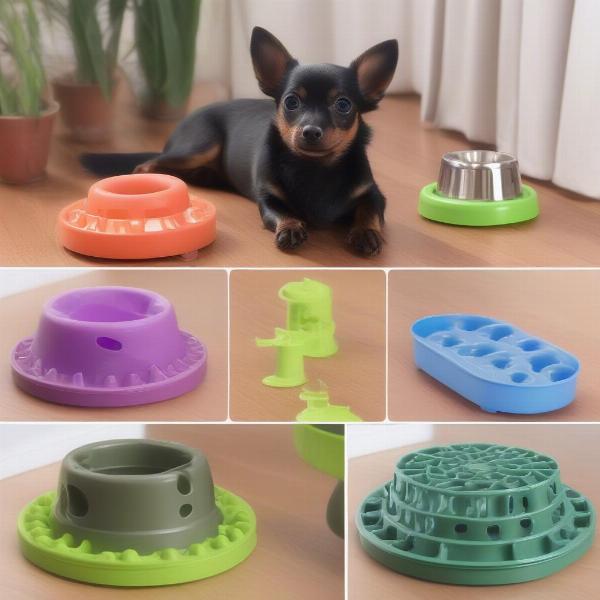Small dog slow feeders are essential tools for promoting healthy eating habits in our petite canine companions. They transform mealtime from a frantic gulp-fest into a more relaxed and enjoyable experience. This not only prevents choking and digestive upset but also provides mental stimulation and can even help with weight management.
Why Use a Slow Feeder for Your Small Dog?
Many small breeds are prone to gulping down their food in record time. This can lead to a number of issues, including choking, vomiting, and bloat, a potentially life-threatening condition. Slow feeders combat this by physically obstructing rapid eating, forcing your dog to take smaller bites and slow down.
Benefits of Slow Feeders
- Prevents choking and vomiting: The design of slow feeders makes it difficult for small dogs to swallow large mouthfuls of food, reducing the risk of choking and regurgitation.
- Reduces bloat risk: By slowing down eating, slow feeders help prevent the rapid ingestion of air that can contribute to bloat, especially in deep-chested small breeds.
- Aids digestion: Eating more slowly allows for better digestion and nutrient absorption.
- Provides mental stimulation: Figuring out how to get to the food provides a fun and engaging challenge for your dog.
- Helps with weight management: Eating slowly allows your dog to feel full sooner, which can be helpful for managing weight.
Choosing the Right Small Dog Slow Feeder
There are many different types of slow feeders available, so choosing the right one can feel overwhelming. Consider your dog’s size, breed, and eating habits when making your selection.  Various slow feeders for small dogs, including bowls, mats, and puzzles.
Various slow feeders for small dogs, including bowls, mats, and puzzles.
Types of Slow Feeders
- Bowls with raised obstacles: These bowls have ridges or other obstacles that prevent dogs from scooping up large amounts of food.
- Mats: These flat mats have a textured surface that makes it more challenging for dogs to eat quickly. They are particularly good for dogs who like to lick their food.
- Puzzles: These feeders require dogs to solve puzzles to get to their food, providing extra mental stimulation.
Introducing a Slow Feeder to Your Small Dog
Introducing a slow feeder should be a gradual process to avoid stress and ensure your dog accepts the new feeding method. Start by adding a small amount of food to the slow feeder and letting your dog explore it. Gradually increase the amount of food in the slow feeder as your dog becomes more comfortable with it.
Tips for a Smooth Transition
- Start with a small amount of food: Don’t fill the slow feeder completely at first.
- Make it positive: Use positive reinforcement, such as praise and treats, to encourage your dog to use the slow feeder.
- Be patient: It may take some time for your dog to get used to the slow feeder. Don’t give up!
- Supervise your dog: Always supervise your dog when they are using a slow feeder to make sure they are not getting frustrated or injured.
Conclusion
Small dog slow feeders are a valuable investment in your furry friend’s health and well-being. By slowing down eating, they can help prevent choking, bloat, and other digestive issues. They also offer mental stimulation and can assist with weight management. With so many benefits, incorporating a slow feeder into your small dog’s mealtime routine is a smart choice.
FAQ
- Are slow feeders suitable for all small dogs? Yes, slow feeders can benefit most small dogs, especially those prone to gulping their food.
- How do I clean a slow feeder? Most slow feeders are dishwasher safe or can be easily cleaned with soap and water.
- What if my dog refuses to use a slow feeder? Try different types of slow feeders or introduce it gradually with positive reinforcement.
- Can puppies use slow feeders? Yes, slow feeders can be used for puppies as well.
- Are there slow feeders for wet food? Yes, there are slow feeders designed specifically for wet food.
- How do I choose the right size slow feeder for my small dog? Consider your dog’s breed and eating habits. If you’re unsure, consult a pet store professional.
- Can using a slow feeder help my dog lose weight? While a slow feeder can aid in weight management, it’s important to combine it with a balanced diet and regular exercise.
Related Articles
ILM Dog is your trusted resource for comprehensive dog care information. We provide expert advice on dog breeds, health, training, nutrition, grooming, and much more. Whether you’re a new dog owner or a seasoned pro, ILM Dog offers practical tips and resources to help you provide the best possible care for your canine companion. Contact us today for personalized guidance: Email: [email protected], Phone: +44 20-3965-8624. Visit our website at ILM Dog for more information.